Speed settings Citroen GRAND C4 PICASSO 2017 2.G Owner's Manual
[x] Cancel search | Manufacturer: CITROEN, Model Year: 2017, Model line: GRAND C4 PICASSO, Model: Citroen GRAND C4 PICASSO 2017 2.GPages: 527, PDF Size: 12.91 MB
Page 8 of 527
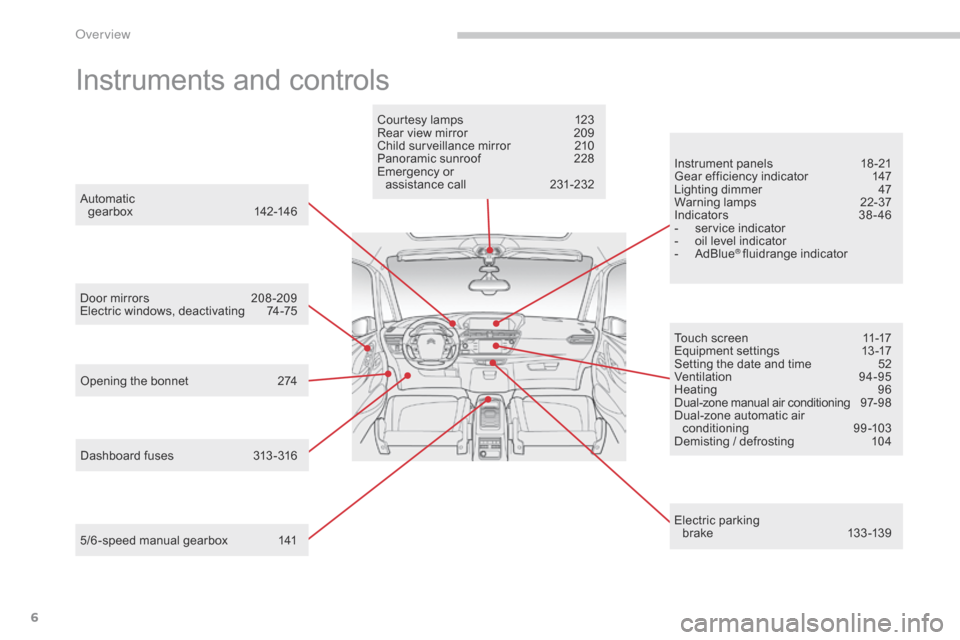
6
C4-Picasso-II_en_Chap00b_vue-ensemble_ed02-2016
Instruments and controls
Touch screen 11-17
Equipment settings 1 3-17
Setting the date and time
5
2
Ventilation
9
4-95
Heating
9
6
Dual-zone manual air conditioning
9
7- 98
Dual-zone automatic air conditioning
9
9-103
Demisting / defrosting
1
04
Door mirrors
2
08 -209
Electric windows, deactivating
7
4-75
5/6 -speed manual gearbox
1
41
Automatic
gear box
14
2-146
Opening the bonnet
2
74 Courtesy lamps
1
23
Rear view mirror
2
09
Child surveillance mirror
2
10
Panoramic sunroof
2
28
Emergency or assistance call
2
31-232
Instrument panels
1
8 -21
Gear efficiency indicator
1
47
Lighting dimmer
4
7
Warning lamps
2
2-37
Indicators
3
8 - 46
-
s
ervice indicator
-
o
il level indicator
-
Ad
Blue
® fluidrange indicator
Electric parking brake
13
3 -13 9
Dashboard fuses
3
13 -316
Over view
Page 17 of 527
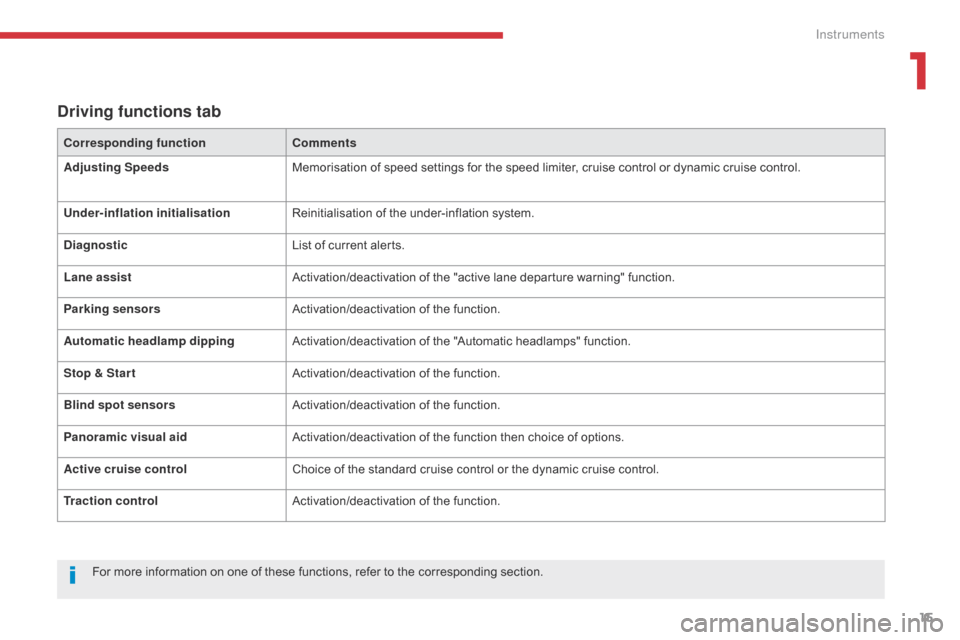
15
C4-Picasso-II_en_Chap01_instruments-bord_ed02-2016
Driving functions tab
Corresponding functionComments
Adjusting Speeds Memorisation of speed settings for the speed limiter, cruise control or dynamic cruise control.
Under-inflation initialisation Reinitialisation of the under-inflation system.
Diagnostic List of current alerts.
Lane assist Activation/deactivation of the "active lane departure warning" function.
Parking sensors Activation/deactivation of the function.
Automatic headlamp dipping Activation/deactivation of the "Automatic headlamps" function.
Stop & Star t Activation/deactivation of the function.
Blind spot sensors Activation/deactivation of the function.
Panoramic visual aid Activation/deactivation of the function then choice of options.
Active cruise control Choice of the standard cruise control or the dynamic cruise control.
Traction control Activation/deactivation of the function.
For more information on one of these functions, refer to the corresponding section.
1
Instruments
Page 20 of 527
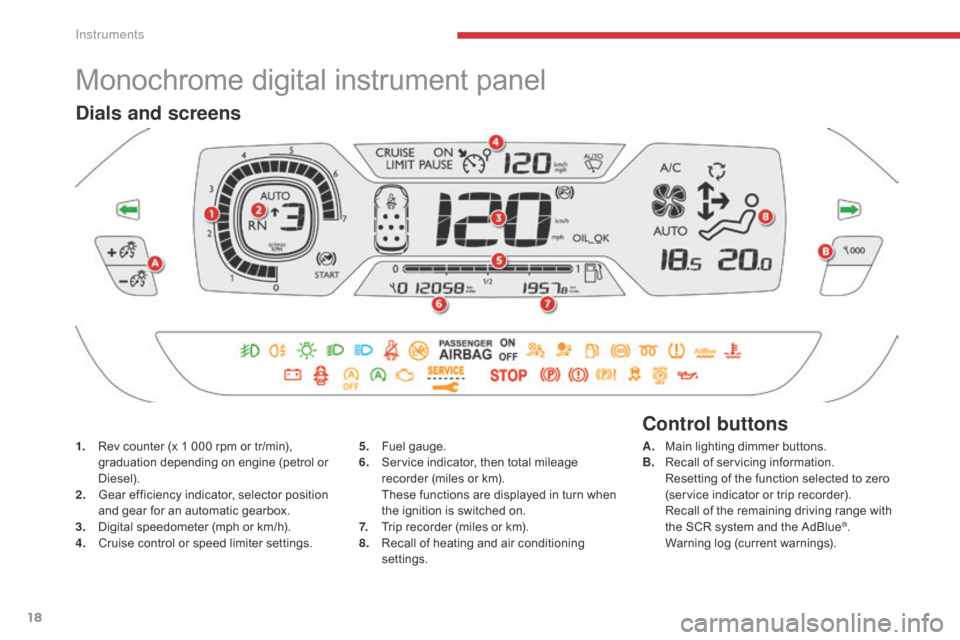
18
C4-Picasso-II_en_Chap01_instruments-bord_ed02-2016
Monochrome digital instrument panel
1. Rev counter (x 1 000 rpm or tr/min), graduation depending on engine (petrol or
Diesel).
2.
G
ear efficiency indicator, selector position
and gear for an automatic gearbox.
3.
D
igital speedometer (mph or km/h).
4.
C
ruise control or speed limiter settings.
Dials and screens
5. Fuel gauge.
6. Service indicator, then total mileage
recorder (miles or km).
T
hese functions are displayed in turn when
the ignition is switched on.
7.
T
rip recorder (miles or km).
8.
R
ecall of heating and air conditioning
settings. A. M
ain lighting dimmer buttons.
B. R ecall of servicing information.
R
esetting of the function selected to zero
(service indicator or trip recorder).
R
ecall of the remaining driving range with
the SCR system and the AdBlue
®. W
arning log (current warnings).
Control buttons
Instruments
Page 153 of 527

151
C4-Picasso-II_en_Chap04_conduite_ed02-2016
Memorising speeds
Memorising
This function allows speeds to be saved, which can then be offered to set the two systems: the speed limiter (to limit the speed of the vehicle) or the
cruise control (for a vehicle cruising speed).
You can memorise up to six speed settings for each of the two systems. By default, some speed settings are already memorised.F
S
elect the system for which you want to
memorise new speed settings.
This function is accessible in the Driving
menu
of the touch screen.
F
Sel
ect the " Driving functions " tab, then
" Speed settings ".
F
P
ress the button corresponding to the
speed setting you want to modify.
As a safety measure, the driver must
carry out these operations when
stationary.
F
E
nter the new value using the numerical
keypad and confirm.
4
Driving
Page 155 of 527

153
C4-Picasso-II_en_Chap04_conduite_ed02-2016
Display in the instrument panel
1. Indication of the speed limit. or
2.
I
ndication of the end of the speed limit.
Display of the speed
The system is active but is not detecting speed
limit information.
On detection of speed limit information, the
system displays the value. The driver can, if desired, adjust the
speed of the vehicle according to the
information given by the system.
The system is activated or deactivated in the
Driving menu of the touch screen.
Select the " Vehicle settings " tab, then
" Security " and "Recommended speed
display ".
Activation / Deactivation
It is necessary to update your
navigation mapping regularly in order to
receive accurate information on speed
limits from the system.
4
Driving
Page 166 of 527
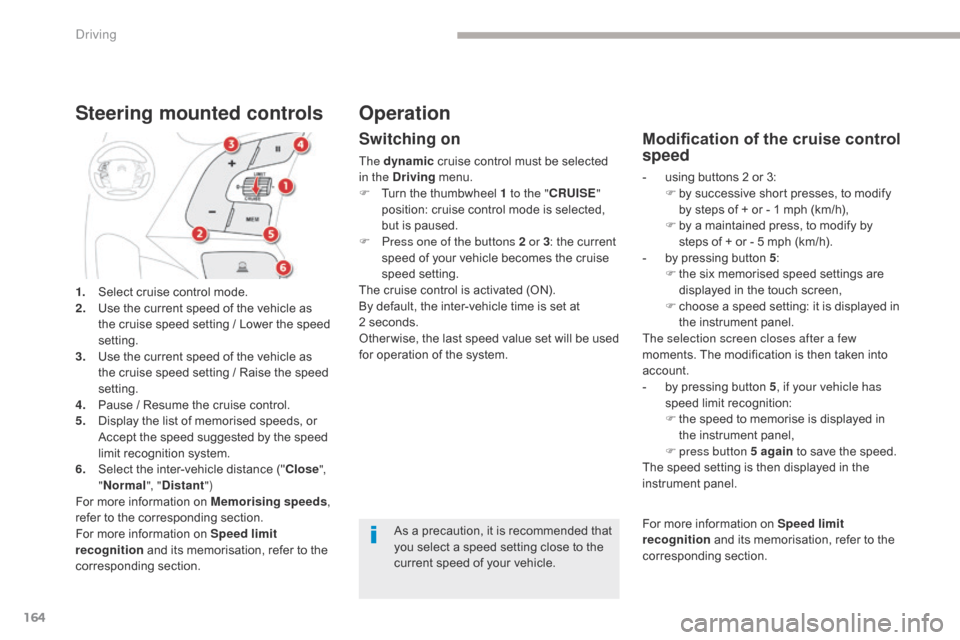
164
C4-Picasso-II_en_Chap04_conduite_ed02-2016
1. Select cruise control mode.
2. Use the current speed of the vehicle as
the cruise speed setting / Lower the speed
setting.
3.
U
se the current speed of the vehicle as
the cruise speed setting / Raise the speed
setting.
4.
P
ause / Resume the cruise control.
5.
D
isplay the list of memorised speeds, or
A
ccept the speed suggested by the speed
limit recognition system.
6.
S
elect the inter-vehicle distance (" Close",
" Normal ", "Distant ")
For more information on Memorising speeds ,
refer to the corresponding section.
For more information on Speed limit
recognition and its memorisation, refer to the
corresponding section.
Steering mounted controls
Switching on
The dynamic cruise control must be selected
in the Driving menu.
F
T
urn the thumbwheel 1 to the " CRUISE"
position: cruise control mode is selected,
but is paused.
F
P
ress one of the buttons 2 or 3 : the current
speed of your vehicle becomes the cruise
speed setting.
The cruise control is activated (ON).
By default, the inter-vehicle time is set at
2
seconds.
Other wise, the last speed value set will be used
for operation of the system.
Modification of the cruise control
speed
- using buttons 2 or 3: F b y successive short presses, to modify
by steps of + or - 1 mph (km/h),
F
b
y a maintained press, to modify by
steps of + or - 5 mph (km/h).
-
b
y pressing button 5 :
F
t
he six memorised speed settings are
displayed in the touch screen,
F
c
hoose a speed setting: it is displayed in
the instrument panel.
The selection screen closes after a few
moments. The modification is then taken into
account.
-
b
y pressing button 5 , if your vehicle has
speed limit recognition:
F
t
he speed to memorise is displayed in
the instrument panel,
F
press button 5 again to save the speed.
The speed setting is then displayed in the
instrument panel.
As a precaution, it is recommended that
you select a speed setting close to the
current speed of your vehicle.
Operation
For more information on Speed limit
recognition and its memorisation, refer to the
corresponding section.
Driving
Page 175 of 527

173
C4-Picasso-II_en_Chap04_conduite_ed02-2016
Modification of the inter-vehicle distance setting
Three predefined inter-vehicle distance settings
are offered:
-
"
Distant" (3 dashes),
-
"
Normal" (2 dashes),
-
"
Close" (1 dash). Engine running and cruise control selected
(grey), you can modify the inter-vehicle
distance setting:
F
p
ress button 6 to display the selection
screen for inter-vehicle distance,
F
p
ress button 6 repeatedly to cycle through
the predefined settings.
The selection screen closes after a
few seconds.
The modification is then taken into account.
This setting remains in memory, whatever the
state of the system and when the ignition is
switched off.
It is possible to exceed the speed setting
temporarily by depressing the accelerator
pedal.
The cruise control no longer manages the
braking system during this period.
Simply release the accelerator pedal to return
to the programmed speed.
If the programmed speed setting is exceeded,
the display of the speed setting disappears
and a message "Cruise control suspended"
is displayed until the accelerator pedal is
released.
Exceeding the programmed
setting
4
Driving
Page 183 of 527
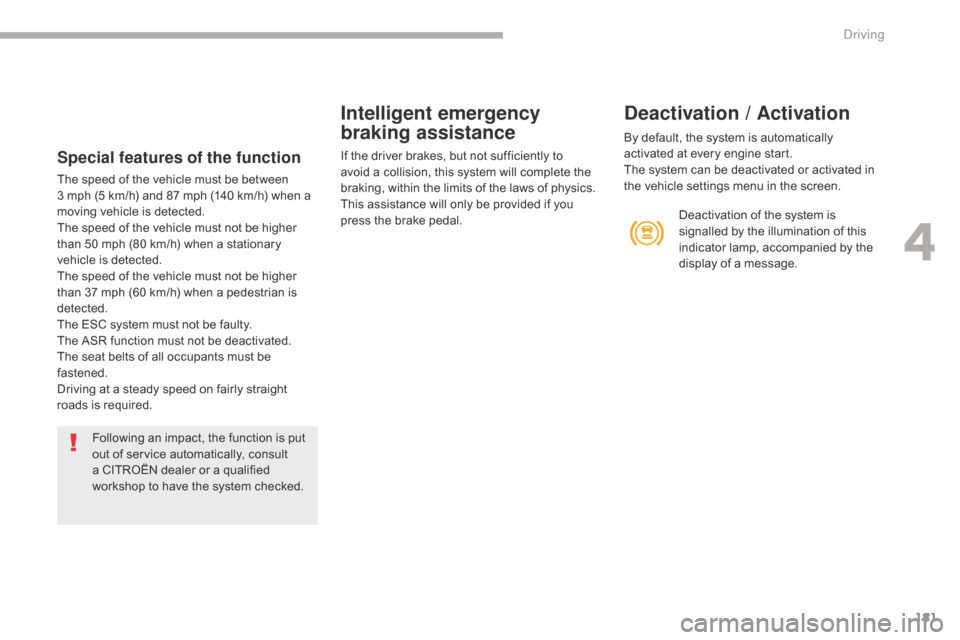
181
C4-Picasso-II_en_Chap04_conduite_ed02-2016
Special features of the function
The speed of the vehicle must be between
3 mph (5 km/h) and 87 mph (140 km/h) when a
moving vehicle is detected.
The speed of the vehicle must not be higher
than 50 mph (80 km/h) when a stationary
vehicle is detected.
The speed of the vehicle must not be higher
than 37 mph (60 km/h) when a pedestrian is
detected.
The ESC system must not be faulty.
The ASR function must not be deactivated.
The seat belts of all occupants must be
fastened.
Driving at a steady speed on fairly straight
roads is required.
Following an impact, the function is put
out of service automatically, consult
a CITROËN dealer or a qualified
workshop to have the system checked.
Intelligent emergency
braking assistance
If the driver brakes, but not sufficiently to
avoid a collision, this system will complete the
braking, within the limits of the laws of physics.
This assistance will only be provided if you
press the brake pedal.
Deactivation / Activation
By default, the system is automatically
activated at every engine start.
The system can be deactivated or activated in
the vehicle settings menu in the screen. Deactivation of the system is
signalled by the illumination of this
indicator lamp, accompanied by the
display of a message.
4
Driving
Page 192 of 527

190
C4-Picasso-II_en_Chap04_conduite_ed02-2016
Fatigue detection system
It is recommended that you take a break as soon as you feel tired or at least every two hours.
Depending on version, the function either has the "Driving time warning" only, or this combined with the "Fatigue detection system".
Driving time warning
The system triggers an alert once it detects that
the driver has not taken a break after two hours
of driving at a speed above 40 mph (65 km/h).
This alert takes the form of the display of a
message encouraging you to take a break,
accompanied by an audible signal.
If the driver does not follow this advice, the
alert is repeated hourly until the vehicle is
stopped.
The system cannot in any
circumstances replace the need for
vigilance on the part of the driver.
Do not take the wheel if you are tired.
As soon as the speed of the vehicle
drops below 40 mph (65 km/h), the
system goes into standby.
The driving time is counted again once
the speed is above 40 mph (65 km/h).
The system resets itself if one of the following
conditions is met:
-
e
ngine running, the vehicle has been
stationary for more than 15 minutes,
-
t
he ignition has been switched off for a
few
m
inutes,
-
t
he driver's seat belt is unfastened and
their door is open.
The system is activated or deactivated in the
touch screen tablet.
Activation / Deactivation
In the Driving
menu, select the " Vehicle
settings " tab, then " Security" and "Fatigue
Detection System ".
Driving
Page 211 of 527
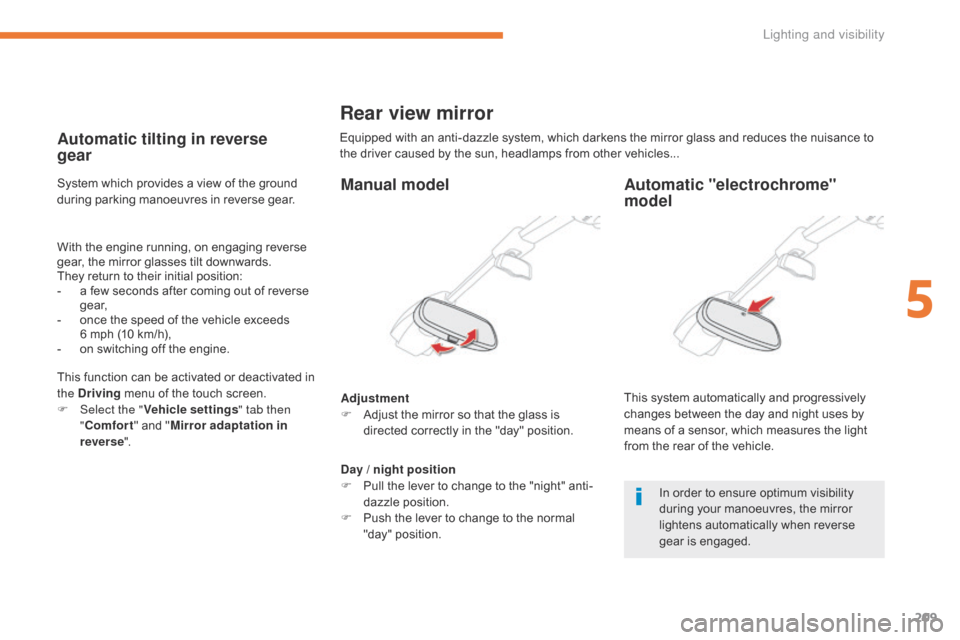
209
C4-Picasso-II_en_Chap05_eclairage-visibilite_ed02-2016
Rear view mirror
Equipped with an anti-dazzle system, which darkens the mirror glass and reduces the nuisance to
the driver caused by the sun, headlamps from other vehicles...
Manual model
Adjustment
F A djust the mirror so that the glass is
directed correctly in the "day" position.
In order to ensure optimum visibility
during your manoeuvres, the mirror
lightens automatically when reverse
gear is engaged.
Day / night position
F
P
ull the lever to change to the "night" anti-
dazzle position.
F
P
ush the lever to change to the normal
"day" position.
Automatic "electrochrome"
model
This system automatically and progressively
changes between the day and night uses by
means of a sensor, which measures the light
from the rear of the vehicle.
Automatic tilting in reverse
gear
With the engine running, on engaging reverse
gear, the mirror glasses tilt downwards.
They return to their initial position:
-
a f
ew seconds after coming out of reverse
g e a r,
-
o
nce the speed of the vehicle exceeds
6
mph (10 km/h),
-
o
n switching off the engine.
System which provides a view of the ground
during parking manoeuvres in reverse gear.
This function can be activated or deactivated in
the Driving
menu of the touch screen.
F
Sel
ect the " Vehicle settings " tab then
" Comfort " and "Mirror adaptation in
reverse ".
5
Lighting and visibility